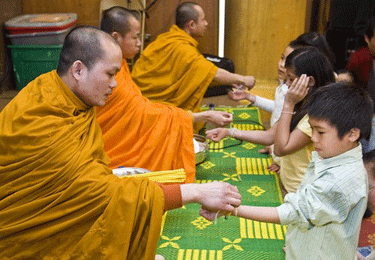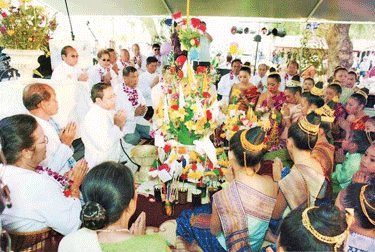
Amidst the divisive strains that have prevailed in the political life of most of our people, the Sinhala and Tamil New Year reminds us of a forgotten message. In fact, this new year emphasises the underlying oneness of our society. It reflects the homogeneity of thought and tradition that binds those born on this soil, whether they live in the North or the South. The common, mood of festivity, goodwill and generosity between the two communities, the nearness of their astrological timings and the parallels in ritualistic observances all confirm deeply rooted historical associations between the Sinhalese and Tamils. These bonds show themselves large enough to establish a common allegiance, a common identity with the land of their birth.
The New Year generally includes rites and ceremonies that are an expression of the renewal of life.
Renewals mark the course of life in nature and in human existence. The survival of the Sinhala and Tamil New Year through long periods of colonialism and Westernisation testifies to the strength of natural phenomena in this country. It establishes the depth and durability of an indigenous culture. It bears witness to the long traditions that grew out of Lanka’s own ancient civilisation.
Pudhu Varu Dam at New Year marks the Hindu solar New Year beginning on the first of the Tamil month of Chittirai. The New year is an auspicious occasion for Hindus. In Punjab, Haryana, Assam, Bengal, Kerala, Tamil Nadu, Nepal, Bangladesh, Burma, Thailand, Cambodia and Laos, New Year is celebrated. Indeed, from time immemorial the Hindus have considered the transition of the Sun as an auspicious event, for the Sun is the presiding deity of the planetary system and the entry from Pisces, the last house in the Zodiac to Aries, the first house is significant, marking the beginning of a new year.
The Hindu almanac known as the Panchaangam, substantiated by astrological calculations, gives us the exact time of the dawn of the New Year.
In fact, April also marks the birth of Spring. Even in the Sangam Classics, there are references to the joyous activities or spring. The great epics Silappadikaram gives us a vivid description of Indra Vizha.
The Lord Indra referred to in Silappadikaram is associated with festivals of this nature. Lord Indra is considered to be a god of protection and in view of these favourable factors, the Hindus have counted upon Siththirai (April) as the first month of the year.
On the New Year day, the Hindus particularly the women, get up early in the morning and anoint themselves with Maruthu Neer (herbal water) obtained usually from Kovils and have a bath during the Punniya Kalam (auspicious time). They wear new clothes and go to temples for worship.
In temples, the bells ring loudly, heralding the birth of the New Year. The cuckoo peals the dawn of the melodious birth of spring with many tunes.

The gentle dawn breeze embraces everyone and instils a sense of new hope and confidence. In homes, milk rice is cooked with jaggery and offered to the Sun. The poor are treated to lavish meals.
The workers, relatives and neighbours join in merry making. The first handling of money for the New Year is carried out at the auspicious time. This is called Kaiveshesham and is always received from good-hearted people. It is also considered to be a lucky transaction and one looked forward to for a year of plenty and prosperity.
To the young, particularly the children, it is a day of sport and fun. They enjoy themselves, wearing new clothes and lighting crackers. Youth enjoy themselves with Porthenkai (crushing of coconuts).
This sport is said to have come to Tamil Nadu from Greece during an era when there was brisk trade between Greece and Rome.
Young girls engage themselves in games such as riding swings. In the evening, dance and music recitals are organised in the principal villages and towns. The New Year festival is significant to one and all since everyone is endeavouring to bring about peace, ethnic harmony and reconciliation in Sri Lanka.
On the many festivals observed in different parts of the Hindu world, the New Year has been one in which all the people – be they from village or town, whatever class or society they belong to, await with great eagerness. The arrival of the New Year fills them with great happiness. The New Year is a festival of freedom, peace, unity and compassion crystallised in the last hymn on unity in the Indian Spiritual text the Rig Veda
“Let your aim be one and single
Let your heart be joined in one,
The mind at rest in unison at peace with all, so you may be”
Source : http://www.defence.lk




